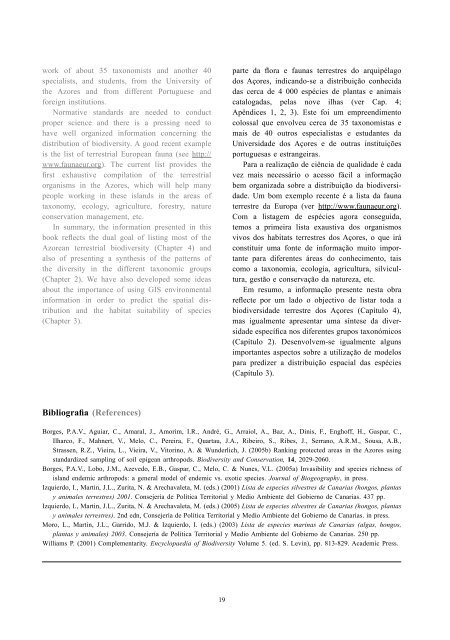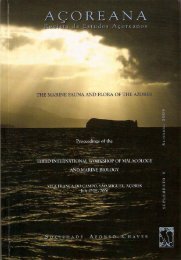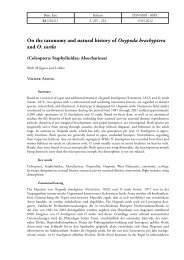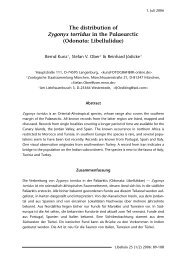(eds.) (2005). - Portal da Biodiversidade dos Açores - Universidade ...
(eds.) (2005). - Portal da Biodiversidade dos Açores - Universidade ...
(eds.) (2005). - Portal da Biodiversidade dos Açores - Universidade ...
You also want an ePaper? Increase the reach of your titles
YUMPU automatically turns print PDFs into web optimized ePapers that Google loves.
work of about 35 taxonomists and another 40<br />
specialists, and students, from the University of<br />
the Azores and from different Portuguese and<br />
foreign institutions.<br />
Normative stan<strong>da</strong>rds are needed to conduct<br />
proper science and there is a pressing need to<br />
have well organized information concerning the<br />
distribution of biodiversity. A good recent example<br />
is the list of terrestrial European fauna (see http://<br />
www.faunaeur.org). The current list provides the<br />
first exhaustive compilation of the terrestrial<br />
organisms in the Azores, which will help many<br />
people working in these islands in the areas of<br />
taxonomy, ecology, agriculture, forestry, nature<br />
conservation management, etc.<br />
In summary, the information presented in this<br />
book reflects the dual goal of listing most of the<br />
Azorean terrestrial biodiversity (Chapter 4) and<br />
also of presenting a synthesis of the patterns of<br />
the diversity in the different taxonomic groups<br />
(Chapter 2). We have also developed some ideas<br />
about the importance of using GIS environmental<br />
information in order to predict the spatial distribution<br />
and the habitat suitability of species<br />
(Chapter 3).<br />
Bibliografia (References)<br />
19<br />
parte <strong>da</strong> flora e faunas terrestres do arquipélago<br />
<strong>dos</strong> <strong>Açores</strong>, indicando-se a distribuição conheci<strong>da</strong><br />
<strong>da</strong>s cerca de 4 000 espécies de plantas e animais<br />
cataloga<strong>da</strong>s, pelas nove ilhas (ver Cap. 4;<br />
Apêndices 1, 2, 3). Este foi um empreendimento<br />
colossal que envolveu cerca de 35 taxonomistas e<br />
mais de 40 outros especialistas e estu<strong>da</strong>ntes <strong>da</strong><br />
Universi<strong>da</strong>de <strong>dos</strong> <strong>Açores</strong> e de outras instituições<br />
portuguesas e estrangeiras.<br />
Para a realização de ciência de quali<strong>da</strong>de é ca<strong>da</strong><br />
vez mais necessário o acesso fácil a informação<br />
bem organiza<strong>da</strong> sobre a distribuição <strong>da</strong> biodiversi<strong>da</strong>de.<br />
Um bom exemplo recente é a lista <strong>da</strong> fauna<br />
terrestre <strong>da</strong> Europa (ver http://www.faunaeur.org).<br />
Com a listagem de espécies agora consegui<strong>da</strong>,<br />
temos a primeira lista exaustiva <strong>dos</strong> organismos<br />
vivos <strong>dos</strong> habitats terrestres <strong>dos</strong> <strong>Açores</strong>, o que irá<br />
constituir uma fonte de informação muito importante<br />
para diferentes áreas do conhecimento, tais<br />
como a taxonomia, ecologia, agricultura, silvicultura,<br />
gestão e conservação <strong>da</strong> natureza, etc.<br />
Em resumo, a informação presente nesta obra<br />
reflecte por um lado o objectivo de listar to<strong>da</strong> a<br />
biodiversi<strong>da</strong>de terrestre <strong>dos</strong> <strong>Açores</strong> (Capítulo 4),<br />
mas igualmente apresentar uma síntese <strong>da</strong> diversi<strong>da</strong>de<br />
específica nos diferentes grupos taxonómicos<br />
(Capítulo 2). Desenvolvem-se igualmente alguns<br />
importantes aspectos sobre a utilização de modelos<br />
para predizer a distribuição espacial <strong>da</strong>s espécies<br />
(Capítulo 3).<br />
Borges, P.A.V., Aguiar, C., Amaral, J., Amorim, I.R., André, G., Arraiol, A., Baz, A., Dinis, F., Enghoff, H., Gaspar, C.,<br />
Ilharco, F., Mahnert, V., Melo, C., Pereira, F., Quartau, J.A., Ribeiro, S., Ribes, J., Serrano, A.R.M., Sousa, A.B.,<br />
Strassen, R.Z., Vieira, L., Vieira, V., Vitorino, A. & Wunderlich, J. (<strong>2005</strong>b) Ranking protected areas in the Azores using<br />
stan<strong>da</strong>rdized sampling of soil epigean arthropods. Biodiversity and Conservation, 14, 2029-2060.<br />
Borges, P.A.V., Lobo, J.M., Azevedo, E.B., Gaspar, C., Melo, C. & Nunes, V.L. (<strong>2005</strong>a) Invasibility and species richness of<br />
island endemic arthropods: a general model of endemic vs. exotic species. Journal of Biogeography, in press.<br />
Izquierdo, I., Martin, J.L., Zurita, N. & Arechavaleta, M. (<strong>eds</strong>.) (2001) Lista de especies silvestres de Canarias (hongos, plantas<br />
y animales terrestres) 2001. Consejería de Política Territorial y Medio Ambiente del Gobierno de Canarias. 437 pp.<br />
Izquierdo, I., Martin, J.L., Zurita, N. & Arechavaleta, M. (<strong>eds</strong>.) (<strong>2005</strong>) Lista de especies silvestres de Canarias (hongos, plantas<br />
y animales terrestres). 2nd edn, Consejería de Política Territorial y Medio Ambiente del Gobierno de Canarias. in press.<br />
Moro, L., Martin, J.L., Garrido, M.J. & Izquierdo, I. (<strong>eds</strong>.) (2003) Lista de especies marinas de Canarias (algas, hongos,<br />
plantas y animales) 2003. Consejería de Política Territorial y Medio Ambiente del Gobierno de Canarias. 250 pp.<br />
Williams P. (2001) Complementarity. Encyclopaedia of Biodiversity Volume 5. (ed. S. Levin), pp. 813-829. Academic Press.

















